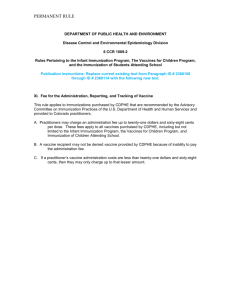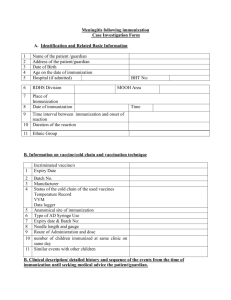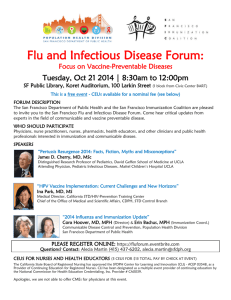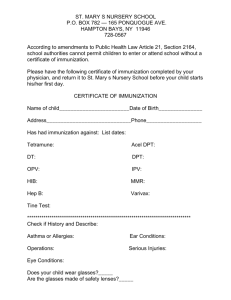Childhood immunization : how knowledgeable are we?
advertisement
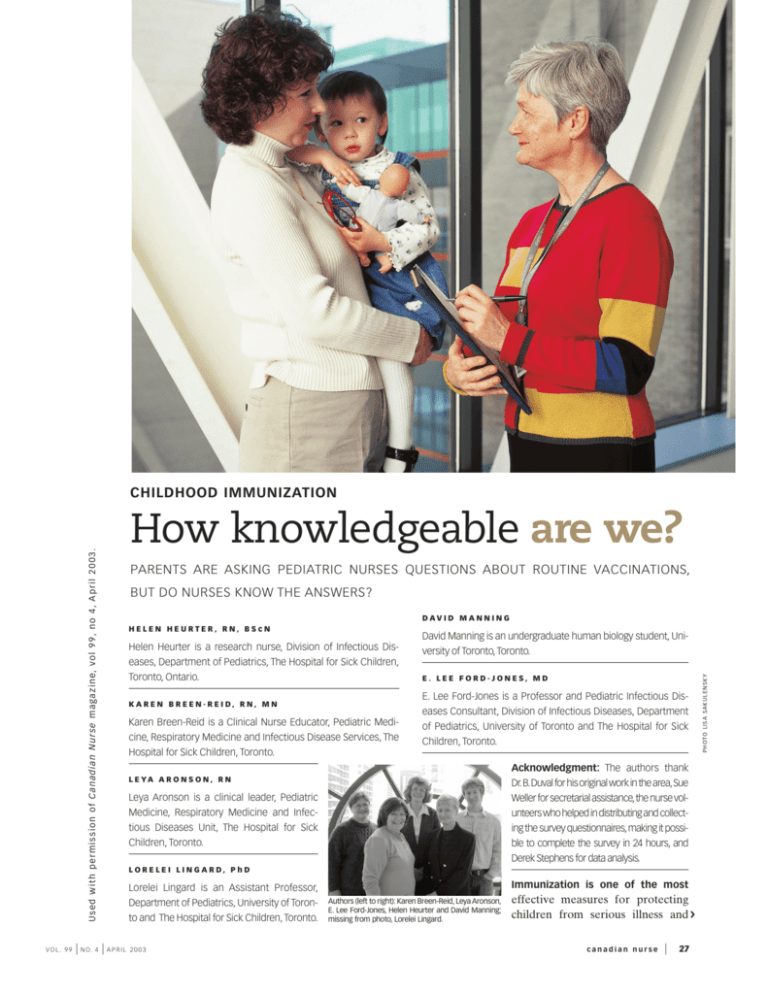
VOL. 99 | N O. 4 | A P R I L How knowledgeable are we? PARENTS ARE ASKING PEDIATRIC NURSES QUESTIONS ABOUT ROUTINE VACCINATIONS, BUT DO NURSES KNOW THE ANSWERS? DAV I D M A N N I N G HELEN HEURTER, RN, BScN Helen Heurter is a research nurse, Division of Infectious Diseases, Department of Pediatrics, The Hospital for Sick Children, Toronto, Ontario. K A R E N B R E E N - R E I D, R N, M N Karen Breen-Reid is a Clinical Nurse Educator, Pediatric Medicine, Respiratory Medicine and Infectious Disease Services, The Hospital for Sick Children, Toronto. David Manning is an undergraduate human biology student, University of Toronto, Toronto. P H OTO L I S A S A K U L E N S K Y U s e d w i t h p e r m i s s i o n o f C a n a d i a n N u r s e m a g a z i n e, v o l 9 9 , n o 4 , A p r i l 2 0 0 3 . CHILDHOOD IMMUNIZATION E. LEE FORD-JONES, MD E. Lee Ford-Jones is a Professor and Pediatric Infectious Diseases Consultant, Division of Infectious Diseases, Department of Pediatrics, University of Toronto and The Hospital for Sick Children, Toronto. Acknowledgment: The authors thank Dr.B.Duval for his original work in the area,Sue Weller for secretarial assistance,the nurse volunteers who helped in distributing and collecting the survey questionnaires,making it possible to complete the survey in 24 hours, and Derek Stephens for data analysis. L E YA A R O N S O N , R N Leya Aronson is a clinical leader, Pediatric Medicine, Respiratory Medicine and Infectious Diseases Unit, The Hospital for Sick Children, Toronto. L O R E L E I L I N G A R D, P h D Lorelei Lingard is an Assistant Professor, Department of Pediatrics, University of Toronto and The Hospital for Sick Children, Toronto. 2003 Immunization is one of the most Authors (left to right): Karen Breen-Reid, Leya Aronson, E. Lee Ford-Jones, Helen Heurter and David Manning; missing from photo, Lorelei Lingard. effective measures for protecting children from serious illness and canadian nurse | › 27 death resulting from vaccine-preventable disconfidence in providing information about eases. Vaccines have been so successful that immunization to parents. For example, the many parents no longer fear many diseases proceedings from the 1996, 1998 and 2000 that can cause permanent harm or even death. National Immunization Conferences4 contain no data about pediatric nurses’ knowlMany do not remember, for example, when edge and attitudes toward immunization in paralytic poliomyelitis was rampant. Fuelled tertiary care centres in Canada. by stories and myths in the popular press about In 1992, researchers at the University of the possible dangers of vaccines, parents ques- A MONTREAL Virginia Health Sciences Centre surveyed tion the necessity and safety of vaccinating STUDY IN 1998 46 pediatric nurses about their knowledge of their children.1 The erosion of confidence in immunization through complacency and misin- ASSESSED THE the recommended immunizations for formation could lead to a resurgence of vacinfants and children and to learn their perATTITUDES, cine-preventable diseases. ceptions of the nurse’s role in immunizaIn addition to being trusted sources of informa- BELIEFS AND tion.5 Of the 30 nurses who responded, 25 (83%) thought that nurses in a tertiary care tion, nurses are one of the health care providers centre need to play an important role in who have “a professional obligation to educate PRACTICES immunization, yet it was found that many parents and to correct misconceptions.”2 Nurses OF 53 NURSES are excellent educators, and pediatric nurses in all may not have sufficient knowledge to implesettings should take opportunities to discuss the ment this role. A Montreal study in 1998 importance of immunization.3 Considering those stateassessed the attitudes, beliefs and practices of 53 nurses ments, a group of nurses, a physician and an educational (78% of whom were immunization providers) involved consultant at a large university-affiliated, pediatric tertiary in an early perinatal intervention program for lowhealth care centre in Ontario recently tested the hypotheincome families.6 A concerning one-fifth of these nurses were unsure about or agreed with statements that sis that pediatric nurses are asked for immunization inforhomeopathy, good nutrition and healthy lifestyle could mation by parents and other members of the public. Other eliminate the need for immunization. Another study purposes of our study were to determine whether the nursfrom Quebec revealed that only 59 per cent of nurse es feel prepared for this role, whether they support routine vaccinators considered vaccines completely safe, effecchildhood immunization and whether they think that they tive and useful.7 Other authors state that nurses workshould have a general working knowledge about this topic. ing in acute care may have difficulty in maintaining L I T E R AT U R E R E V I E W knowledge of immunization schedules and may not see There is little published literature looking at hospiimmunization as a key component of acute care in tal-based pediatric nurses’ knowledge of and level of comparison to the other aspects of care.8 Table 1: Reliance on pediatric nurses for immunization information Question (number responding among 421 respondents) Response Yes No Do you administer immunizations as part of your practice at HSC? (n=417) n 91 % 22 n 326 % 78 Are you asked for immunization information? (n=419) 312 74 107 26 79 108 64 36 22 3 25 35 21 11 7 1 If Yes, when asked for immunization information do you feel prepared to answer? (n = 288) 131 45 157 55 Do you think that it is desirable for all pediatric nurses to have a general working knowledge about immunization? (n = 418) 410 97 8 2 If Yes: (n=312) ■ by colleagues ■ by friends ■ by family ■ by neighbours ■ by parents of your patients ■ by other Note: Respondents could circle more than one item. 28 | canadian nurse APRIL 2003 | VOL. 99 | N O. 4 Table 2: Knowledge of childhood immunization schedule among pediatric nurses, n=416 (99%) Question Yes Do you know the current recommended immunization schedule for children in Ontario? 137 (33%) Somewhat, know where to find it 166 (40%) Among those nurses who have children ages six months to 15 years (n = 151) 72 (48%) 55 (37%) 16 (11%) 5 (3%) Among those nurses who do not have children ages six months to 15 years (n = 270) 65 (24%) 111 (41%) 56 (21%) 36 (13%) METHODS No, know where to find it No, don’t know where to find it 72 (17%) 41 (10%) R E S U LT S At our pediatric tertiary health care centre,we performed a Of the 499 questionnaires distributed, 421 (84%) were self-administered convenience sample survey of all nurses completed, either fully or partially; not every nurse working during a 24-hour period in June 2001.A simple 13answered all questions. Unanswered questionnaires item,one-page questionnaire was developed and pre-tested (n=78) were also collected.The majority of nurses (74%) for clarity and comprehension among seven nurses in differindicated that they were asked for immunization inforent roles such as direct care, research and infection control. mation, yet over half (55%) did not feel prepared to The survey was approved by the Chief Nursing Officer, answer questions. Only 22 per cent (n= 90 of the 417 who nursing administrators and the Research Ethics Board. A answered the question) administered immunizations as week prior to the survey date, an announcement about the part of their practice. Of the 418 who answered the quesforthcoming survey was placed in the hospital’s weekly tion asking whether they thought all pediatric nurses newsletter and on the internal nursing Web site. Based on should have a working general knowledge about pediaverage staffing numbers provided by nursing administraatric immunization, 410 (98%) agreed (see Table 1). tion, it was estimated that approximately 500 nurses would Various sources of immunization information were listbe present at work during any given 24-hour period. ed in the questionnaire, and respondents could choose On the survey date, the questionnaire and explanatomore than one. There was no consistency in their ry letter were given to every nurse who came to work. responses. The most frequently indicated sources were The sample included nurses working in inpatient and popular media (48%), pediatricians, medical outpatient areas, education, administration residents and fellows working at the instituRESPONDENTS and research. Study collaborators and a team tion (41%) and nursing journals (40%). Thirof volunteer nurses distributed the question- WHO HAD ty-three per cent of respondents reported that naires to all locations where it was known that they knew the current recommended immunurses were working. The number of nurses CHILDREN SIX nization schedule for children in Ontario. scheduled to work in each area for the 24- MONTHS TO Another 40 per cent said that they somewhat hour period was obtained and matched to the knew the schedule and knew where to find it. number of questionnaires distributed. A $1 15 YEARS OF AGE The remainder indicated that they did not coupon for a local coffee franchise was know the schedule. Self-report responses WERE TWICE AS attached to the letter as a thank-you in recogwere not further validated. Respondents who nition of each nurse’s time. Questionnaires, LIKELY TO SAY had children six months to 15 years of age both answered and unanswered, were collectwere twice as likely to say that they knew the ed the same day or the following morning.All THAT THEY schedule as those who did not have children questionnaires were counted and collated (48% compared to 24%) (see Table 2). KNEW THE twice to ensure accuracy in the numbers of Respondents who did not know the schedule questionnaires distributed and returned. SCHEDULE were asked to comment. Of the 39 who wrote a Data were entered into an Excel database. comment, 25 provided reasons that included Descriptive statistics and content analysis were not being up-to-date in immunization knowlused. Frequencies were used to describe cateedge (n=9), the knowledge not being required gorical data and cross tabulations to measure in their practice (n=7), not having children of associations between two or more categorical immunization age (n=3), being new to the variables. Questionnaire items requesting comprovince (n=3) and not having their own chilments were separated and analysed for themes. dren (n=3). › VOL. 99 | N O. 4 | A P R I L 2003 canadian nurse | 29 Nurses were asked what level of support they half felt adequately prepared to answer would give to individual vaccines. The number of questions. nurses who answered the questions about whether Nurses were given the opportunity to add a they would recommend the routine use of individcomment at the end of the questionnaire. Of ual vaccines ranged from 94 per cent (n=395 of the 65 nurses who did so, the majority 421) for MMR (measles, mumps, rubella) to 89 per requested educational materials/resources cent (n=374 of 421) for varicella.Support was highregarding immunization. Seven expressed er for the vaccines that have been longer in routine anti-immunization ideas. Of these, six indiNURSES WERE use, such as DaPTPolio-Hib (diphtheria, pertussis, cated that they were unsure about the efficatetanus, poliomyelitis, Haemophilus influenzae b) ASKED WHAT cy of immunization and one simply claimed and MMR. None of the vaccines received a 100 to be against immunization. per cent recommendation rate by the respon- LEVEL OF It was not surprising to learn that most nursdents. Of the 395 respondents who answered for es do not know the current recommended SUPPORT THEY DaPTPolio-Hib, 94 per cent (n=371) indicated immunization schedule, given that the nurses “always,” three per cent (n=11) “sometimes” and WOULD GIVE surveyed were involved in tertiary rather than three per cent (n=13) “never.” For the 396 who primary care and that the schedule is changresponded about MMR, 92 per cent (n=364) TO INDIVIDUAL ing with the introduction of new vaccines. indicated “always,” five per cent (n=20) “some- VACCINES A concerning finding was the lack of total times” and three per cent (n=12) “never.” Of the support for the vaccines recommended for 385 respondents to the question about hepatitis B vacchildren in Ontario as of June 2001 although the “expeccine, 65 per cent (n=252) stated “always,” 27 per cent tation is that most nurses are highly supportive of immu(n=104) “sometimes” and eight per cent (n=29) “never.” nization.”9 No information was collected for conjugate pneumococcal or meningococcal vaccines. These vacOf the 381 nurses who responded about influenza vaccines had not been recommended by the National Advicine, 43 per cent (n=162) indicated “always,” 42 per cent sory Committee on Immunization (NACI) at the time (n=161) “sometimes” and 14 per cent (n=58) “never.” of the survey. Since the survey, NACI has recommended Varicella vaccine received the least support with only 47 the routine use of conjugate meningococcal vaccines in per cent (175 of 374) stating “always,” 39 per cent October 2001 and conjugate pneumococcal vaccine in (n=145) “sometimes” and 14 per cent (n=54) “never” January 2002. (see Table 3). It is important to note that for each vaccine, The sources that nurses used to obtain their immunizaseven of the respondents who indicated “never” also tion information varied. A large number of respondents stated that they were not asked for immunization infor(n=160 of 403) indicated nursing journals as a source of mation. As a result, it is not known from this survey information. Curious about which Canadian nursing jourwhether the reason for not recommending the individual nals contained articles on immunization, one member of vaccines was that they were not asked for the informaour research team completed a CINAHL search of nursing tion or that they did not support vaccines. journals published during 2000 and 2001. The key words DISCUSSION “nurse,” “immunization,” “vaccine,” “child” and “infant” The study confirmed the hypothesis that nurses at a were used. Only two Canadian journal articles were locatpediatric tertiary care centre are asked for immunizaed,and neither contained education information on immution information. Although almost all respondents nization efficacy or the risks and benefits of immunization. (98%) thought that they should have a general working It might be questioned whether nurses used resources that knowledge about childhood immunization, fewer than would effectively meet their knowledge needs for practice. Table 3: Support for specific vaccines among pediatric nurses. Survey, The Hospital for Sick Children, June 2001 Questionnaires returned, n=421 Question Do you recommend the routine use of the following immunizations in normal healthy children DaPTPolio-Hib MMR Hepatitis B Influenza Varicella Response Always 371 364 252 162 175 (94%) (92%) (65%) (43%) (47%) Sometimes 11 20 104 161 145 (3%) (5%) (27%) (42%) (39%) Never* 13 12 29 58 54 (3%) (3%) (8%) (15%) (14%) Number of responses per vaccine 395 396 385 381 374 (94%) (94%) (91%) (90%) (89%) * Seven nurses who chose “Never” said that they are not asked for immunization information. 30 | canadian nurse APRIL 2003 | VOL. 99 | N O. 4 immunization.11 We need to equip pediatric nurses with The popular press (newspapers,television,magazines) was indicated by 48 per cent of participants as at least one easily accessible, accurate resources so that they can prosource of immunization information; however, it is not vide immunization information to parents, patients and known what types of information participants were gleanother health care professionals.The finding that none of the ing from these non-professional sources or how much they vaccines listed received 100 per cent recommendation sugsupported it. We did not correlate which of these respongests a need for implementing educational sessions about dents also indicated using professional sources, such as vaccine-preventable diseases and available vaccines. Other journals, lectures and Web sites.A recent study of Canadiconsiderations for application of our findings might include an chiropractic students showed that students who reportcurriculum evaluation in the pediatric component at unied anti-vaccination attitudes relied primarily on informal versities and colleges; an immunization component in RN sources of vaccine information.10 refresher courses; and inclusion of immunization in continThere were several limitations to our study. We chose a uing education courses for re-licensing requirements. convenience sample of all nurses working during one 24The survey heightened awareness among many staff hour period at our centre.The 421 nurses who responded nurses that they require more information to feel confirepresent approximately 84 per cent of those working dent and competent in providing accurate immunization during that time and only 30 per cent of the 1,340 nurses information to families. Interest has increased in particithen employed at the hospital.The voluntary participation pating in education sessions and in creating and dissemiof the respondents introduced a degree of selfnating information.For example,after the surIT WAS NOT selection, and the results may not be generalized vey, one nurse who also works in a medical to nurses who did not complete the questionnaire WITHIN THE clinic provided inservices to nursing colnor to those who were not involved in the survey. leagues in the tertiary setting about the We did not obtain data about respondents’ level SCOPE OF OUR administration of immunizations because this of education in immunization,years of experience STUDY TO was one skill topic of concern on her unit. or work setting. Pediatric nurses have a responsibility to It was not within the scope of our study to EXPLORE THE ensure long-term success in eradicating explore the reasons why respondents did not recvaccine-preventable diseases through ommend individual vaccines. Nor did we corre- REASONS WHY parental education and completing immulate the respondents’ choices for obtaining their RESPONDENTS nization histories for their patients.12 Education programs and resources have been own vaccine information with their support for shown to influence nursing knowledge and vaccines. It was not a focus of our study to exam- DID NOT practice in the community setting and ine how nurses develop their perception of the RECOMMEND could be beneficial in increasing the level efficacy of immunization and whether their cliniof support for immunization assessment cal experiences affected their thinking or respons- INDIVIDUAL and provision in the acute care setting.13 es to families. An interesting study would be to We hope to develop such an education proinvestigate further how nurses obtain their immu- VACCINES gram for the acute care nurses in our facilinization information and how they evaluate the ty and to evaluate its success in increasing information that may be shared with families. nurses’ immunization knowledge and confiF U T U R E C O N S I D E R AT I O N S dence in discussing immunization with parThe Canadian Nurses Association has strongly recents, other health care professionals and the ommended that nurses maintain support for public. u REFERENCES 1. Halperin, S. How to manage parents unsure about immunization, Canadian Journal of CME, January, 2000, 62-74. 2. Gellin, B., Maibach, E. and Marcuse, E. Do parents understand immunizations? A national telephone survey. Pediatrics, 106, 2000, 1097-1102. 3. Stinchfield, P. Vaccine safety communication: The role of the paediatric nurse. Journal of the Society of Paediatric Nurses, 6(3), 2001, 143-146. 4. Canadian National Immunization Conference Reports for 1996, 1998 and 2000, available online at www.hc-sc.gc.ca/pphb-dgspsp/cnic-ccni/, a Health Canada Web site. 5. Dixon, M., Keeling, A.W. and Kennel, S. What pediatric hospitals know about immunization, American Journal of Maternal and Child Nursing, 19(2), 1994, 64-68. 7. Dionne, M., Boulianne, N. and Duval, B. Manque de conviction face à la vaccination chez les vaccinateurs québécois, Canadian Journal of Public Health, 92(2), 2001, 100-104. 8. D’Lugoff, M. and Schalla, K. Vaccine verification guide: Demystifying childhood immunizations for inpatient and other nurses, Pediatric Nursing, 26(1), 2000, 69-75. 9. Nursing Policy Division, Canadian Nurses Association. Nurses and immunization: What you need to know! Nursing NOW, 12, 2001, 5-8. 10. Busse, J.W., Kulkarni, A.B., Campbell, J.B. and Injeyan, H.S. Attitudes toward vaccination: A survey of Canadian chiropractic students, Canadian Medical Association Journal, 166(12), 2002, 1531-1534. 11. Nursing Policy Division, CNA, 2001. 6. Hudson, P., Soto, J., Duchesne, C. et al. Psychosocial determinants of immunization among health care providers working in a support program for low-income families in Montreal, poster presentation at 12. Biester, D.J. Childhood immunization: Nursing’s role and responsibility, Journal of Pediatric Nursing, 7(1), 1992, 65-66. 13. Mawn, B. and Pakkala, K. Immunization update: A community-based the 4th Canadian National Immunization Conference, Halifax, nursing education program, Journal of Continuing Education in Nursing, December 3-6, 2000. 31(2), 200, 101-109. VOL. 99 | N O. 4 | A P R I L 2003 canadian nurse | 31




